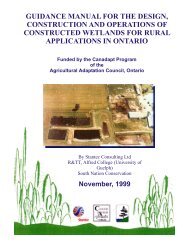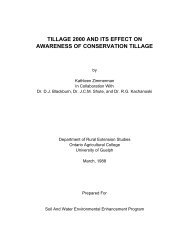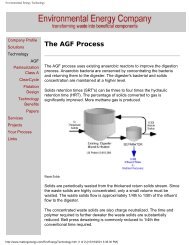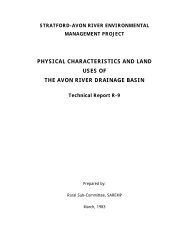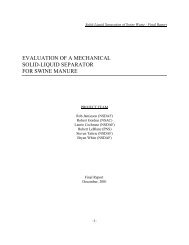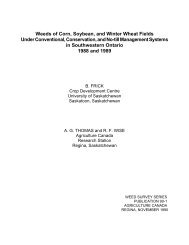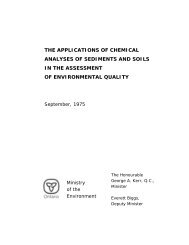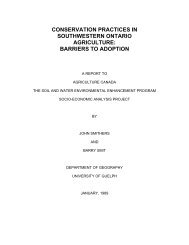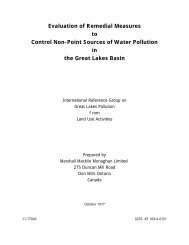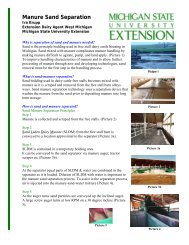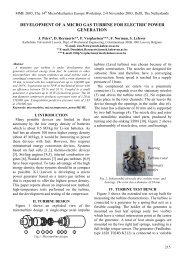Environmental Aspects of Phosphate and Potash Mining United ...
Environmental Aspects of Phosphate and Potash Mining United ...
Environmental Aspects of Phosphate and Potash Mining United ...
You also want an ePaper? Increase the reach of your titles
YUMPU automatically turns print PDFs into web optimized ePapers that Google loves.
The <strong>Environmental</strong> Approach <strong>of</strong> the <strong>Phosphate</strong> Rock <strong>and</strong> <strong>Potash</strong> <strong>Mining</strong> Industry<br />
The waste slimes <strong>and</strong> brine are transferred underground<br />
through a slurry pipeline <strong>and</strong> discharged to the<br />
excavated salt rooms. Generally, two or three salt rooms<br />
are filled simultaneously. Deposition <strong>and</strong> settling <strong>of</strong> the<br />
slimes occurs in one room, while the clarified brine<br />
overflows into the second <strong>and</strong>/or third.<br />
The clarified brine is recovered from the salt rooms <strong>and</strong><br />
returned to the processing plant where it is evaporated<br />
to produce both a fresh water condensate, <strong>and</strong> a concentrated<br />
brine. The fresh water condensate is used<br />
largely as an input to the process with excess released<br />
through the holding pond. The concentrated brine is<br />
returned to the crystallization circuit for recovery <strong>of</strong><br />
residual potassium chloride.<br />
The water balance <strong>of</strong> the operation is essentially<br />
closed. Water released from the site is related to either<br />
on-site rain or snowfall or the excess fresh water condensate<br />
from the processing facility. Both <strong>of</strong> these<br />
sources are retained in a continuously monitored holding<br />
pond prior to release to the local river.<br />
The adoption <strong>of</strong> the closed circuit waste loop, demonstrates<br />
some <strong>of</strong> the benefits that arise from an effective<br />
pollution prevention program. The potential sources <strong>of</strong><br />
pollution in the form <strong>of</strong> the three major waste streams<br />
have been integrated into the mining process. The salt<br />
tailings have become an essential component <strong>of</strong> the cut<br />
<strong>and</strong> fill mining method, recycling <strong>of</strong> the brines has<br />
increased product recovery <strong>and</strong> eliminated the need for<br />
contaminated discharges, <strong>and</strong> the slimes <strong>and</strong> some<br />
brine are effectively disposed <strong>of</strong> in the salt rooms.<br />
The major environmental benefit <strong>of</strong> the approach is the<br />
small surface impact <strong>of</strong> the operation. The lack <strong>of</strong> any<br />
surface salt tailings stack, slime <strong>and</strong> brine ponds has<br />
reduced the potential for surface environmental<br />
impacts to negligible levels.<br />
The approach does incur an additional cost in comparison<br />
to conventional surface waste disposal methods. In<br />
the case <strong>of</strong> the New Brunswick operation, this has been<br />
partially <strong>of</strong>fset by greater recovery <strong>of</strong> the potash ore<br />
resource, lower product transportation costs due to the<br />
operations location with respect to markets <strong>and</strong> a<br />
potentially a lower future rehabilitation cost during<br />
operation closure.<br />
32<br />
Treatment <strong>of</strong> the Clay Fines to Remove Salts<br />
The IMC <strong>Potash</strong> Colonsay operation in Saskatchewan,<br />
Canada is developing a process to remove salt <strong>and</strong><br />
brines from the clay slimes waste. Removal <strong>of</strong> the salt<br />
allows the insolubles to be disposed <strong>of</strong> without special<br />
precautions.<br />
The process involves a number <strong>of</strong> steps:<br />
Separation <strong>of</strong> the slime component by thickening to<br />
remove brine;<br />
Washing <strong>of</strong> the slimes with water to dissolve any<br />
residual salt;<br />
Cycloning to remove brine;<br />
Filtering with the addition <strong>of</strong> fresh water to produce a<br />
relatively dry, desalinated product.<br />
The filtered slurry forms small, stable, agglomerated<br />
particles, facilitating h<strong>and</strong>ling <strong>and</strong> reducing the likelihood<br />
<strong>of</strong> dust problems.<br />
Results from earlier trials are being used to improve the<br />
process.<br />
This method removes the need for large areas to be set<br />
aside for clay slimes settling ponds. The slimes are<br />
instead converted into an environmentally benign, easily<br />
disposed product that may possibly be sold as a clay<br />
substitute for brick <strong>and</strong> pottery or a water retention<br />
amendment for s<strong>and</strong>y soils.<br />
Figure 3.6.5<br />
Flowsheet <strong>of</strong> the slimes desalination <strong>and</strong><br />
dewatering process. IMC <strong>Potash</strong>, Canada.<br />
Fresh<br />
water<br />
Clay, salt fines<br />
<strong>and</strong> brine<br />
Cold slimes<br />
thickener<br />
Filter<br />
Flocculant<br />
Brackish water<br />
Desalinated <strong>and</strong> dewatered clay<br />
(75 - 80% solids)<br />
Washing<br />
Cyclone<br />
Clay<br />
<strong>and</strong><br />
brine



